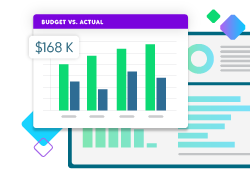How Your Organization’s Charitable Arm Can Manage Restricted Funds to Grow Your Stewardship

Imagine starting a road trip and not knowing how much gas you had in the tank. You might be able to go 300 miles in one stretch, or your car might start beeping 10 minutes down the road, leaving you scrambling to find the nearest gas station.
Without clear insight into the available funds earmarked for charitable arms of larger organizations, it’s difficult to see the complete picture of their financial standing. Are there enough resources to launch this initiative? Was that recent donation specific to a research area or for general use?
The high-level information from the larger organization’s general ledger is often not detailed or current enough to help with more than general strategy. And it usually resides within the parent organization, making the reports harder to access on a regular basis.
With the right tools, 501(c)(3) arms of larger organizations can manage their restricted funds, create a clear roadmap for their programs, and roll up the impact numbers their donors and parent organizations care about.
The Problem with Accounting for Restricted Funds
Donor restricted funds make up a large part of the resources for charitable foundations associated with parent institutions, such as for-profit hospitals, public school systems, and private universities without a 501(c)(3). But the usage requirements and the layers of separation between for-profit and non-profit arms make managing these funds difficult. For philanthropic arms of larger organizations, it’s challenging to get the visibility and transparency you need from the parent organization’s general ledger to make short-term and long-term decisions.
The parent organization’s enterprise resource planning (ERP) system is not configured to handle the required level of granular information that is necessary for 501(c)(3) nonprofits. ERPs are built with profitability in mind, while nonprofits need systems focused on accountability, especially when it comes to restricted funds and regulatory compliance. Because ERPs are not intended for nonprofit use cases, they aren’t set up to track a funding source all the way through to its end. For that reason, it’s difficult for a public school foundation to show that donations to the Marching Band Booster Club were actually used to purchase new trombones, for example.
Similarly, the details about these restricted funds are held within the parent organization’s finance team. No matter how easy-going the accounting staff is, it requires an additional request and time to process the report. That layer slows down the decision-making process for the 501(c)(3).
Not only is the process slow, but it can also be challenging to get timely reports with accurate data. The information from the parent organization often lags a quarter or two behind, so the nonprofit must combine multiple sources of data to get an accurate picture of its finances. Any time you add manual entry into a process, it can result in inaccurate data. Trying to answer questions with stale and possibly incorrect data can lower donors’ trust—and their interest in supporting the organization again.
Financial Stewardship Through Restricted Fund Accounting Software
One way for your charitable arm to get the clarity they need is by employing its own fund accounting software for restricted funds. Fund accounting software can act as a sub-ledger to your parent organization’s general ledger, rolling up the information they require while providing the granular details you need to make decisions.
A subsidiary ledger accounting system, or sub-ledger, takes a section of the general ledger and allows the charitable arm to manage that information more granularly. Using the same field names and categories makes it easy to pass important data up to the general ledger, giving the parent organization what they need to know. The sub-ledger can be the same platform as the general ledger, but it doesn’t have to be. Through APIs, many systems can integrate seamlessly.
Because the sub-ledger is managed by the charitable arm of the organization, it can be configured to the needs of the 501(c)(3). With a platform purpose-built for nonprofits, the fund accounting software offers multiple layers of controls, which can maintain proper segregation of duties and compliance with accounting standards. The nonprofit leadership can create different approval paths and reporting structures to make sure funds are spent appropriately. They can also establish restrictions on where funds can be pulled from and accurately document those withdrawals for reporting. The charitable arm needs real-time visibility into how much money is available to use within a restricted fund, so they don’t overspend or underspend and leave funds on the table.
That transparent reporting is the most important aspect of a restricted fund accounting system. With accurate and timely data, your charitable arm can quickly and easily show impact for donors and fund availability for stakeholders. The foundation can code transactions for easy tracking and establish dashboards that show the information they need to see. The accounting sub-ledger can also automate reporting so the foundation’s staff can proactively address questions from stakeholders without having to request or manually run reports.
How Charitable Foundations Manage Restricted Contributions with Fund Accounting Software
While restricted fund sub-ledgers can help any 501(c)(3) arm of a larger organization, this accounting structure is common in healthcare and education. Healthcare foundations, higher education foundations, and public education foundations work with restricted funds often and need the visibility and clarity that fund accounting software can provide.
Healthcare foundations receive program-specific funding from donors who want to see an impact in a specified area. For example, a large donor might care deeply about finding a cure for colon cancer, so they give a hospital foundation $5 million to focus on that disease. The foundation may use that money along with other grants specifically for colon cancer to purchase equipment to better diagnose and treat patients with colon cancer. Using an accounting sub-ledger makes it easy to identify how much is available for that purchase and provides end-of-year reporting specifically to those donors and grantors.
Blackbaud customer Sarasota Memorial Healthcare Foundation saw this flexibility and visibility soon after incorporating Blackbaud Financial Edge NXT. “I can report back now where the money has come in, what fund it has gone through, and exactly what we’ve spent by project,” said Vice President of Finance and Operations Bobby Pettit. “Frequently, donors ask how the funds have been granted and ultimately the impact their gift has made. This transparency provides additional donor confidence in how we are stewarding their funds, often resulting in recurring donations to the initiative.”
Restricted fund accounting platforms are also popular in education. Public school education foundations manage multiple buckets across individual schools. They provide funds for general needs that the government funding can’t pay for, such as staff appreciation or extra supplies for students who need them. They also manage funds for individual groups such as the robotics club and the baseball boosters. It’s essential that funds are allocated appropriately so the dues for the National Honors Society don’t accidentally pay for the entrance fees for the Debate Team’s next tournament.
More Clarity over Restricted Funds Means Greater Stewardship
When you have more visibility into your fund accounting, you can be a better steward of your donors’ contributions. Not only do you make sure that the funds are used as required, but you can also make faster and more data-driven decisions. With a fund accounting software platform that acts as a sub-ledger to your parent organization’s general ledger, you save time asking for and providing reports, and the organization automatically gets the high-level information they need.
To learn more about how fund accounting platforms can help with your stewardship, check out our four-part on-demand webinar series on the role of finance and technology in successful stewardship.
Fund Accounting Software that Drives Impact
Find out how Blackbaud’s Financial Edge NXT® fits your organization.


